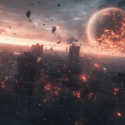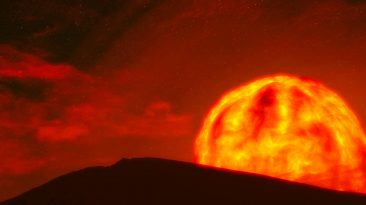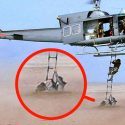There’s a giant, peanut-shaped object orbiting the Sun, and it’s name is Halley’s comet. Like all comets, it’s a cosmic mashup of frozen ice, gases, and dust.
Stretching a vast 15 kilometers by 8 kilometers (9 miles by 5 miles), this space snowball streaks by Earth every 76 years and has been circling for 16,000 years. It hasn’t caused us any trouble yet, but that would change if its elliptical return crosses paths with our Moon, causing a devastating collision visible in broad daylight.
Would it affect space exploration? How much damage would it do to the Moon? What would happen on Earth?
It’s 2061, and crowds are gathering to watch the impending fireworks. We would have known about the impact for a while because of the predictability of the comet’s orbit, and although a scary event, it would be a sight to behold.
The explosion would be similar to the 2013 collision of an asteroid into the Moon which created an eight second light show and left a 40 meter wide crater. Except Halley’s comet is 550 billion times heavier than the 2013 asteroid.
So instead of merely leaving a crater, Halley’s comet would rip the Moon’s surface apart. From the Earth, this would look equal parts beautiful and terrifying.
But on the Moon, it would just be pure terror. Magma from the core of the Moon would spill out, shooting large plumes of dust and material into space.
Particles and smaller debris would be harmless and float around the Moon, but heftier chunks would gain enough speed to escape the velocity of the Moon and enter space. Once in space, they would travel toward Earth, pulled by our planet’s gravity.
Hopefully we would have enough time to prepare, because at this point, people would need to shelter in underground bunkers as fire rains down from above. The last time a large rock exploded in our atmosphere was in 2013.
Chelyabinsk was a 19 meter (62.3 foot) wide meteorite, and it’s explosion was equal to 500,000 tonnes of TNT. Over 1,000 people were injured in Russia.
If any fallout from the Moon was similar in size to Chelyabinsk, whole cities could be destroyed. Eventually, we’d get the all clear to leave our bunkers. Some places would be only moderately damaged, while others would be completely demolished.
Rebuilding would begin, but the effects of Halley’s comet crashing into our Moon would be far from over. Our dreams of continuing space exploration would be dashed.
We would need the Moon as a pitstop to restock and refuel for exploring space. But because of severe damage from the comet collision, landing there would be difficult, if not impossible.
So any thoughts of mining the Moon for the essential raw materials to advance space technology wouldn’t fly. At least NASA and other space agencies would become better funded. The world would rely on them to keep constant track of the dangerous Moon chunks still left in our orbit.
And if you’re speculating all the dust and debris would give Earth a beautiful ring like Saturn’s, well, better luck next time. Or maybe not.
Subscribe to What-If on YouTube or follow the show on Facebook Watch.
Sources
- “Albedo — From Eric Weisstein’s World Of Physics”. 2020. scienceworld.wolfram.com.
- “In Depth | 1P/Halley – NASA Solar System Exploration”. 2020. NASA Solar System Exploration.
- “Halley’s Comet – Where It Is And What It Is”. 2020. theplanetstoday.com.
- “What is Halley’s Comet?”. 2020. phys.org.
- “Komet Halley 1985/86.”. S&W 21: 21-24.
- “Chicxulub Crater – About Chicxulub”. 2020. chicxulubcrater.org.



























